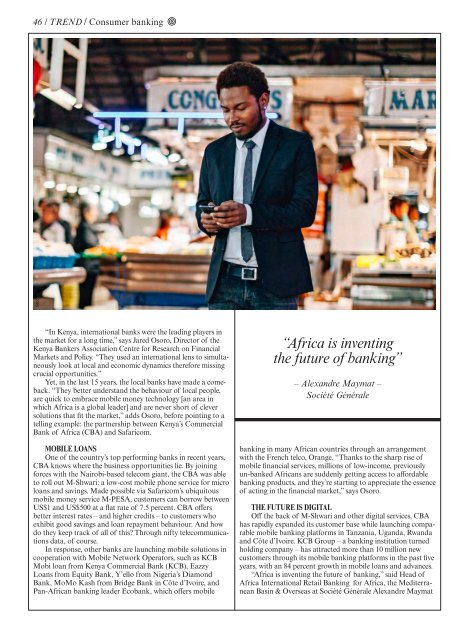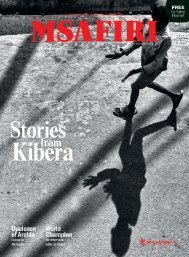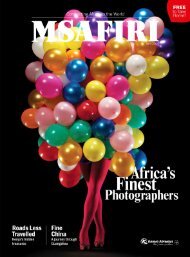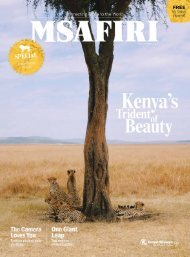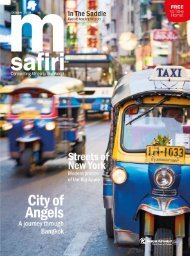Create successful ePaper yourself
Turn your PDF publications into a flip-book with our unique Google optimized e-Paper software.
46 / TREND / Consumer banking<br />
TREND / 47<br />
Stocksy<br />
13<br />
The volume of cashless transactions in<br />
Africa grew by 13% per annum<br />
between 2014 and 2016<br />
86<br />
Africa’s banking market earns approx.<br />
US$86 billion in revenue<br />
100<br />
In Africa today, there are 100 million active<br />
mobile money accounts<br />
129<br />
The revenue from consumer banking in<br />
Africa is expected to reach US$129 billion<br />
in a recent interview with Techmoran. It’s a sign that international<br />
banks are jumping on the bandwagon; in this case, with the help<br />
of YUP, another mobile alternative to the traditional banking<br />
model. “We want to be part of this revolution by offering a simple<br />
transactional tool that’s accessible to all citizens, including the<br />
80 percent who don’t have bank accounts.”<br />
HOT ON THEIR HEELS<br />
A number of the continent’s leading banks have been making<br />
progress through end-to-end digital transformation, sales<br />
productivity and back-office optimisation. A few others have<br />
even launched fully digital banks, such as ALAT bank in Nigeria,<br />
which targets younger customers who are an underserved<br />
segment in Africa’s largest economy, where more than half of<br />
the population is under 30. Some international banks are also<br />
going digital in Africa. The UK’s Standard Chartered Bank, for<br />
example, has opened digital banks in Côte d’Ivoire, Uganda,<br />
Tanzania, Ghana and Kenya. The freshly introduced, fully<br />
digital online banking solution enables customers to open their<br />
own accounts in 15 minutes without ever having to step into a<br />
banking hall.<br />
With fierce competition from non-bank lenders – think<br />
smartphone apps like Saida in Kenya and Aella Credit in Nigeria<br />
– there’s no doubt that the banks still have work to do. This is<br />
good news for African consumers who are finally getting access<br />
to a wide variety of affordable and easily accessible mobile and<br />
digital financial products, not only in payments and deposits,<br />
but across the full spectrum of financial services. It’s fair to<br />
conclude – as Managing Executive, Consumer Banking at Nedbank<br />
Mutsa Chironga does – that today, “Africa’s banking<br />
markets are among the most exciting in the world.”<br />
“In Kenya, international banks were the leading players in<br />
the market for a long time,” says Jared Osoro, Director of the<br />
Kenya Bankers Association Centre for Research on Financial<br />
Markets and Policy. “They used an international lens to simultaneously<br />
look at local and economic dynamics therefore missing<br />
crucial opportunities.”<br />
Yet, in the last 15 years, the local banks have made a comeback.<br />
“They better understand the behaviour of local people,<br />
are quick to embrace mobile money technology [an area in<br />
which Africa is a global leader] and are never short of clever<br />
solutions that fit the market,” adds Osoro, before pointing to a<br />
telling example: the partnership between Kenya’s Commercial<br />
Bank of Africa (CBA) and Safaricom.<br />
MOBILE LOANS<br />
One of the country’s top performing banks in recent years,<br />
CBA knows where the business opportunities lie. By joining<br />
forces with the Nairobi-based telecom giant, the CBA was able<br />
to roll out M-Shwari: a low-cost mobile phone service for micro<br />
loans and savings. Made possible via Safaricom’s ubiquitous<br />
mobile money service M-PESA, customers can borrow between<br />
US$1 and US$500 at a flat rate of 7.5 percent. CBA offers<br />
better interest rates – and higher credits – to customers who<br />
exhibit good savings and loan repayment behaviour. And how<br />
do they keep track of all of this? Through nifty telecommunications<br />
data, of course.<br />
In response, other banks are launching mobile solutions in<br />
cooperation with Mobile Network Operators, such as KCB<br />
Mobi loan from Kenya Commercial Bank (KCB), Eazzy<br />
Loans from Equity Bank, Y’ello from Nigeria’s Diamond<br />
Bank, MoMo Kash from Bridge Bank in Côte d’Ivoire, and<br />
Pan-African banking leader Ecobank, which offers mobile<br />
“Africa is inventing<br />
the future of banking”<br />
– Alexandre Maymat –<br />
Société Générale<br />
banking in many African countries through an arrangement<br />
with the French telco, Orange. “Thanks to the sharp rise of<br />
mobile financial services, millions of low-income, previously<br />
un-banked Africans are suddenly getting access to affordable<br />
banking products, and they’re starting to appreciate the essence<br />
of acting in the financial market,” says Osoro.<br />
THE FUTURE IS DIGITAL<br />
Off the back of M-Shwari and other digital services, CBA<br />
has rapidly expanded its customer base while launching comparable<br />
mobile banking platforms in Tanzania, Uganda, Rwanda<br />
and Côte d’Ivoire. KCB Group – a banking institution turned<br />
holding company – has attracted more than 10 million new<br />
customers through its mobile banking platforms in the past five<br />
years, with an 84 percent growth in mobile loans and advances.<br />
“Africa is inventing the future of banking,” said Head of<br />
Africa International Retail Banking for Africa, the Mediterranean<br />
Basin & Overseas at Société Générale Alexandre Maymat<br />
by 2022<br />
282<br />
Over half of the 282 mobile money<br />
services operating worldwide are located in<br />
Sub-Saharan Africa<br />
300<br />
The number of people becoming<br />
banked grew by from 170 million in 2012<br />
to 300 million in 2017<br />
450<br />
By 2022, 450 million Africans will be<br />
banked, which will be close to half the<br />
population of Africa<br />
“What if these same weak<br />
spots could reveal the answer<br />
to the problem?”<br />
ANP


